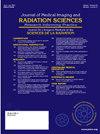传统治疗计划CT扫描的椎体转移诊断成像——一项前瞻性患者研究的结果
IF 2
Q3 RADIOLOGY, NUCLEAR MEDICINE & MEDICAL IMAGING
Journal of Medical Imaging and Radiation Sciences
Pub Date : 2025-05-01
DOI:10.1016/j.jmir.2025.101924
引用次数: 0
摘要
目的/目的通过比较在dCT图像和治疗计划CT (TPCT)图像上创建的剂量沉积模式和大小的差异,评估使用诊断CT (dCT)图像为使用体积调制弧线治疗(VMAT)放射治疗的椎体转移制定和提供姑息放疗治疗计划的可行性。这是一项reb批准的单中心非随机前瞻性队列研究,样本量n=30。创建了一个工作流程,以确保满足治疗计划参数,现有的dCT涵盖了椎体病理的范围。在TPCT时,CT模拟人员使用弯曲的聚苯乙烯泡沫沙发顶复制dCT位置。病人们被纹上了纹身。一个专门的预处理模板提供了设置说明,CT工作人员完成了一份研究问卷。在TPCT上勾画临床靶体积(CTV)和1cm计划靶体积(PTV),制定VMAT治疗方案。患者被安置在弯曲的聚苯乙烯泡沫沙发上的治疗沙发上,并根据安装说明进行定位,而不需要查看纹身。进行CBCT和6-DoF治疗床的对准校正,并开始治疗。治疗服务人员完成了一份研究问卷。CTV/PTV分别在dCT和TPCT上进行轮廓,并在dCT上创建单独的VMAT计划。图像集在CTV水平上严格注册,并将轮廓导出到3D切片器以评估常见的分割指标。在dCT上创建的计划在TPCT上重新计算,并评估TPCT目标覆盖率。结果或益处/挑战迄今为止,接受剂量为2000cGy/5(5例)和800cgy/1(11例)的n=16例(n=5例腰骶部,n=6例腰椎或胸腰椎,n=5例胸部)的结果。平均值±标准偏差目标覆盖率计算TPCT为98.4±5.2%和94.8±9.7%体积获得95%的处方剂量(V95% Rx), 100.0±3.0%和95.2±9.8%剂量(处方剂量的比例)95%的目标卷(D95%)和106.8±3.0%和107.4±2.9%剂量(处方剂量的比例)2%的体积(D2%),分别对CTV和PTV。dCT与TPCT轮廓线的Dice Similarity Coefficient和Hausdorff Distance的平均值±标准差分别为0.87±0.05和0.92±0.03,CTV和PTV分别为2.0±0.5 mm和2.0±0.7 mm。定性问卷强调了dCT/TPCT再现性之间“良好”或“可接受”的一致性;定位纹身未用于患者设置;6-DoF治疗躺椅适当地纠正了患者的排列。预定时间等同于传统的设置和交付时间。结论/影响考虑到迄今为止评估的病例数量,VMAT计划先前获得的dCT扫描为椎体目标提供了可接受的目标覆盖范围,而不会对危险器官产生不可接受的热点。在这种姑息性病例中消除对专门的TPCT的需要有可能加快治疗,减轻患者和放疗资源的负担,而不会造成重大损害。本文章由计算机程序翻译,如有差异,请以英文原文为准。
DIVERT (Diagnostic Imaging for VERTebral metastases) from Conventional Treatment Planning CT Scan - Results of a Prospective Patient Study
Purpose/Aim
To assess the feasibility of using diagnostic CT (dCT) images to create and deliver treatment plans for palliative radiotherapy for vertebral metastases using volumetric modulated arc therapy (VMAT) radiotherapy by comparing differences in the pattern and magnitude of dose deposition between plans created on dCT images and those on treatment planning CT (TPCT) images.
Methods/Process
This is an REB-approved single-center non-randomized prospective cohort study with sample size n=30. A workflow was created to ensure treatment planning parameters were met and the existing dCT covered the extent of vertebral pathology. The dCT position was replicated by CT simulation staff at the time of the TPCT using a curved Styrofoam couch-top. Patients were given setup tattoos. A dedicated pre-treatment template provided setup instructions and CT staff completed a study questionnaire. The clinical target volume (CTV) and 1cm planning target volume (PTV) was contoured on the TPCT, and a VMAT treatment plan was created. Patients were positioned on the treatment couch on a curved Styrofoam couch-top and positioned according to the setup instructions, without viewing tattoos for setup. A CBCT and alignment correction with a 6-DoF treatment couch was performed and treatment delivery was initiated. Treatment delivery staff completed a study questionnaire. The CTV/PTV were independently contoured on both dCT and TPCT, and a separate VMAT plan created on the dCT. The image sets were rigidly registered at the level of the CTV, and contours exported to 3D Slicer for evaluation of common segmentation metrics. The plan created on the dCT was recalculated on the TPCT, and TPCT target coverage was evaluated.
Results or Benefits/Challenges
Results for n=16 (n=5 lumbosacral, n=6 lumbar or thoracolumbar, n=5 thoracic) cases to date, receiving doses of 2000cGy/5 (5) and 800cgy/1 (11). The mean ± standard deviation target coverage as calculated on the TPCT was 98.4 ± 5.2% and 94.8 ± 9.7% for the volume receiving 95% of the prescription dose (V95% Rx), 100.0 ± 3.0% and 95.2 ± 9.8% for the dose (as a percentage of the prescription dose) to 95% of the target volume (D95%), and 106.8 ± 3.0% and 107.4 ± 2.9% for the dose (as a percentage of the prescription dose) to 2% of the volume (D2%), for the CTV and PTV, respectively. The mean ± standard deviation Dice Similarity Coefficient and Hausdorff Distance between dCT and TPCT contours was 0.87 ± 0.05 and 0.92 ± 0.03, and 2.0 ± 0.5 mm and 2.0 ± 0.7 mm for the CTV and PTV, respectively. Qualitative questionnaires highlight ‘good’ or ‘acceptable’ agreement between dCT/TPCT reproducibility; localization tattoos were not used for patient setup; and a 6-DoF treatment couch appropriately corrected patient alignment. Booking time was equal to conventional setup and delivery.
Conclusions/Impact
Given the number of cases assessed to date, VMAT planning on previously acquired dCT scans provides acceptable target coverage to vertebral targets without unacceptable hot spots to organs at risk. Eliminating the need for a dedicated TPCT in such palliative cases has the potential to expedite treatment, reducing the burden on both the patient and radiotherapy resources without significant compromise.
求助全文
通过发布文献求助,成功后即可免费获取论文全文。
去求助
来源期刊

Journal of Medical Imaging and Radiation Sciences
RADIOLOGY, NUCLEAR MEDICINE & MEDICAL IMAGING-
CiteScore
2.30
自引率
11.10%
发文量
231
审稿时长
53 days
期刊介绍:
Journal of Medical Imaging and Radiation Sciences is the official peer-reviewed journal of the Canadian Association of Medical Radiation Technologists. This journal is published four times a year and is circulated to approximately 11,000 medical radiation technologists, libraries and radiology departments throughout Canada, the United States and overseas. The Journal publishes articles on recent research, new technology and techniques, professional practices, technologists viewpoints as well as relevant book reviews.
 求助内容:
求助内容: 应助结果提醒方式:
应助结果提醒方式:


